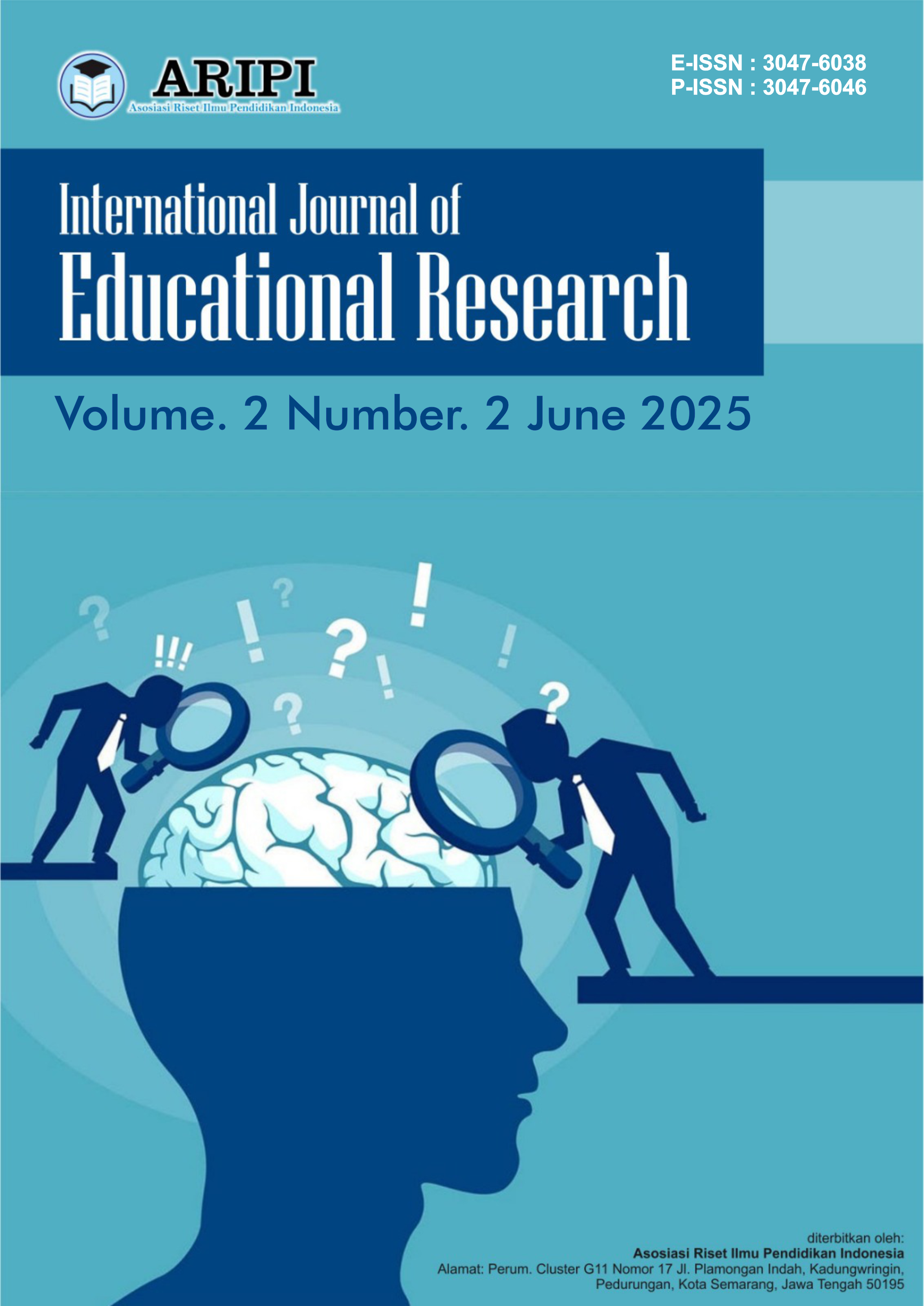Contrastive Analysis of Indonesian and English Phonological Systems: Implications for Pronunciation Teaching
DOI:
https://doi.org/10.62951/ijer.v2i3.411Keywords:
contrastive analysis, Indonesian learners, phonetic interference, phonology, pronunciation teachingAbstract
This contrastive linguistic study examines the phonological systems of Indonesian and English to identify areas of difficulty for Indonesian learners of English pronunciation. Through a systematic comparison of vowel and consonant inventories, phonotactic constraints, stress patterns, and prosodic features, this research identifies key points of interference that contribute to pronunciation challenges. The study employs acoustic analysis of speech samples from 120 Indonesian learners of English across different proficiency levels, combined with perceptual assessments by native English speakers. Findings reveal significant differences in vowel systems, consonant clusters, word stress placement, and intonation patterns that directly correlate with pronunciation difficulties. The research proposes a pedagogical framework that integrates principles of contrastive analysis with contemporary pronunciation teaching methodologies, including explicit phonological instruction, acoustic modelling, and technology-enhanced practice. The implications suggest that pronunciation instruction can be significantly improved through targeted interventions that address language-specific interference patterns while building on positive transfer opportunities.
References
Brown, A. (2020). English pronunciation for international communication: A contrastive approach. Cambridge University Press.
Celce-Murcia, M., Brinton, D., & Goodwin, J. (2023). Teaching pronunciation: A course book and reference guide (3rd ed.). Cambridge University Press.
Chen, L., & Zhang, Y. (2022). Cross-linguistic influence in L2 phonological acquisition: Evidence from acoustic analysis. Applied Linguistics, 43(2), 234–256. https://doi.org/10.1093/applin/amab051
Deterding, D. (2021). Indonesian English pronunciation: Patterns and pedagogical priorities. World Englishes, 40(3), 412–428. https://doi.org/10.1111/weng.12532
Ellis, N. C. (2022). Cognitive linguistics and second language acquisition: From theory to practice. Routledge.
Flege, J. E., & Bohn, O. S. (2021). The revised Speech Learning Model (SLM-r). In R. Wayland (Ed.), Second language speech learning: Theoretical and empirical progress (pp. 3–83). Cambridge University Press. https://doi.org/10.1017/9781108886901.002
Garcia, M., & Rodriguez, P. (2023). Technology-enhanced pronunciation instruction: A systematic review of recent developments. Computer Assisted Language Learning, 36(4), 567–592. https://doi.org/10.1080/09588221.2021.1986743
Handayani, S., & Kurniawan, E. (2022). Prosodic challenges in Indonesian learners' English: A corpus-based study. Indonesian Journal of Applied Linguistics, 12(1), 89–107. https://doi.org/10.17509/ijal.v12i1.41234
Hawkins, S., & Smith, R. (2021). Acoustic characteristics of vowel reduction in non-native English speech. Journal of Phonetics, 87, 101–118. https://doi.org/10.1016/j.wocn.2021.101048
Jenkins, J. (2023). Global Englishes and pronunciation teaching: Past, present and future. Routledge.
Johnson, K. L. (2020). Consonant cluster acquisition in Indonesian learners of English: An optimality theory approach. Second Language Research, 36(4), 445–468. https://doi.org/10.1177/0267658319876544
Kuhl, P. K. (2020). Neural commitment to language: How experience shapes perception across languages. Annual Review of Linguistics, 6, 149–171. https://doi.org/10.1146/annurev-linguistics-031119-122130
Lee, J., & Kim, H. (2024). Mobile applications for pronunciation learning: Effectiveness and user engagement. ReCALL, 36(1), 78–95. https://doi.org/10.1017/S0958344023000123
Liu, Y., & Wang, Q. (2021). Perceptual training effects on English vowel identification by Indonesian learners. Studies in Second Language Acquisition, 43(3), 634–658. https://doi.org/10.1017/S0272263120000388
McMahon, A. (2020). An introduction to English phonology (2nd ed.). Edinburgh University Press.
Munro, M. J., & Derwing, T. M. (2020). Foreign accent, comprehensibility, and intelligibility in the speech of second language learners. Language Learning, 70(S1), 74–105. https://doi.org/10.1111/lang.12398
Nasution, F., & Rahman, A. (2023). Intonation patterns in Indonesian English: A comparative acoustic study. English Language Teaching, 16(3), 45–62. https://doi.org/10.5539/elt.v16n3p45
O’Connor, J. D. (2022). Better English pronunciation (3rd ed.). Cambridge University Press.
Pratiwi, D., & Sari, L. (2021). The effectiveness of explicit pronunciation instruction for Indonesian EFL learners. TEFLIN Journal, 32(2), 178–195. https://doi.org/10.15639/teflinjournal.v32i2.178195
Roach, P. (2021). English phonetics and phonology: A practical course (5th ed.). Cambridge University Press.
Roosman, L. M. (2022). Phonological processes in Indonesian: Implications for English pronunciation teaching. Lingua, 275, 103–118. https://doi.org/10.1016/j.lingua.2022.103367
Setter, J., & Jenkins, J. (2024). Pronunciation in English as a lingua franca: Perspectives on variation and change. Cambridge University Press.
Sneddon, J. N., Adelaar, A., Djenar, D. N., & Ewing, M. C. (2021). Indonesian: A comprehensive grammar (2nd ed.). Routledge.
Thomson, R. I., & Derwing, T. M. (2021). The effectiveness of L2 pronunciation instruction: A narrative review. Applied Linguistics, 42(1), 24–56. https://doi.org/10.1093/applin/amz056
Utami, P., & Setiawan, B. (2020). Word stress errors in Indonesian learners’ English: A contrastive analysis approach. Applied Linguistics Review, 11(4), 623–645. https://doi.org/10.1515/applirev-2019-0087
Williams, J., & Anderson, K. (2023). Virtual reality applications in pronunciation training: Current state and future directions. Language Learning & Technology, 27(2), 89–106. https://doi.org/10.10125/73456
Zhang, L., & Brown, D. (2022). Acoustic modeling in computer-assisted pronunciation training: Recent advances and applications. Computers & Education, 185, 104–119. https://doi.org/10.1016/j.compedu.2022.104511
Downloads
Published
How to Cite
Issue
Section
License
Copyright (c) 2025 International Journal of Educational Research

This work is licensed under a Creative Commons Attribution-ShareAlike 4.0 International License.




